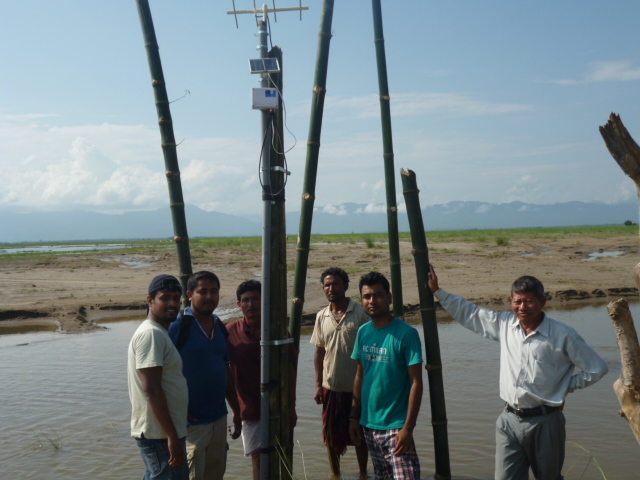The frequency and intensity of flash floods is rapidly increasing in the Himalayan region. Flash floods carrying huge amounts of water, loaded with debris and sediment, are much more hazardous and tend to affect more people than normal monsoon floods. They are also much harder to predict, making them more difficult to manage and prepare for. However, the devastation can be minimized with effective flood forecasting and early warning systems.
While meteorological departments provide some flood forecasts for larger rivers, in the smaller rivers that flow down from the Himalayas, systems for forecasting flash floods or warning local communities are less common. To fill this gap, the International Centre for Integrated Mountain Development (ICIMOD) and Aaranyak, an environmental research and advocacy organization in northeast India, have installed flood early warning system (FEWS) along the Jiadhal and Singara rivers in Assam. Both rivers are tributaries of the Brahmaputra.
In 2010, a timely warning from the FEWS installed in Dihiri, a village in the Jiadhal basin, enabled people to shift their livestock to a safer place one hour before the flood arrived. Another community-based flood early warning system in Dhemaji district has been welcomed by local residents, who see it as a potential life-saver.
In 2013, ICIMOD has already provided eight such systems for installation on different rivers in Assam. Five of them have been installed. After the installation, all the systems are managed by local residents. ICIMOD and Aaranyak have been training residents to manage the system.
An early warning system costs $700–800 and consists of two main components, the transmitter and the receiver. The transmitter is placed in the river close to the bank or in the riverbank, while the receiver is placed in a house near the riverbank. Rising flood levels are detected by the sensor in the transmitter and these signals are transmitted to the receiver using wireless technology. The alert can be instantly communicated to vulnerable people living in downstream areas using mobile phones.
Four of the eight early warning systems installed in Assam this year are in Jiadhal and Singara rivers. The first was installed at Sagarpur village in Lakhimpur district on June 5, World Environment Day. Aaranyak field staff say that all installed equipment have been working successfully, during moderate floods. Now the disaster management authorities in various districts have decided to collaborate in the project, which should improve the sustainability of the system.
Aaranyak field staff are now installing the other three systems and building a network of residents in the two river basins. Meetings to raise awareness about the flood early warning systems are planned.
Based on the experiences in Assam, it is clear that in order for communities to develop their capacity to handle flood and post-flood situations, governments in the Himalayan region must promote the installation of more flood early warning systems on rivers prone to flash floods. Locals must also be given the training and orientation they need to operate the systems and to act upon the warnings.
Sundar Kumar Rai is a Water and Adaptation Analyst, Water and Air, at ICIMOD; Nand Kishor Agrawal is Programme Coordinator of the Himalayan Climate Adaptation programme in the Regional Programme Adaptation to Change at ICIMOD; Partha Jyoti Das is the Head of Water, Climate and Hazard Programme at Aaranyak

